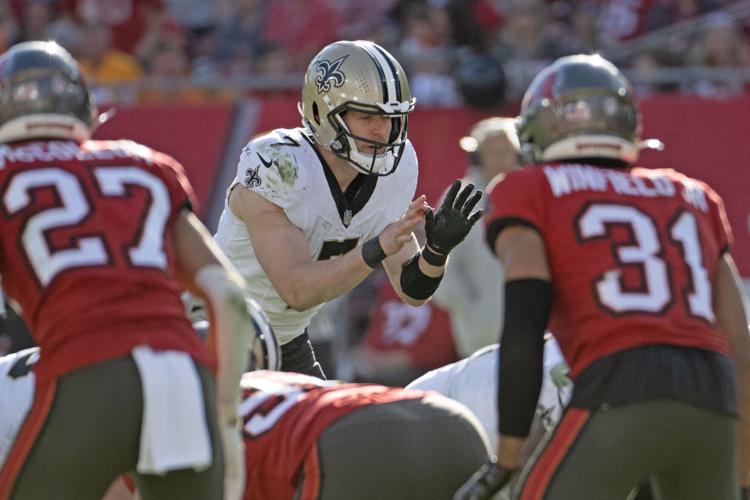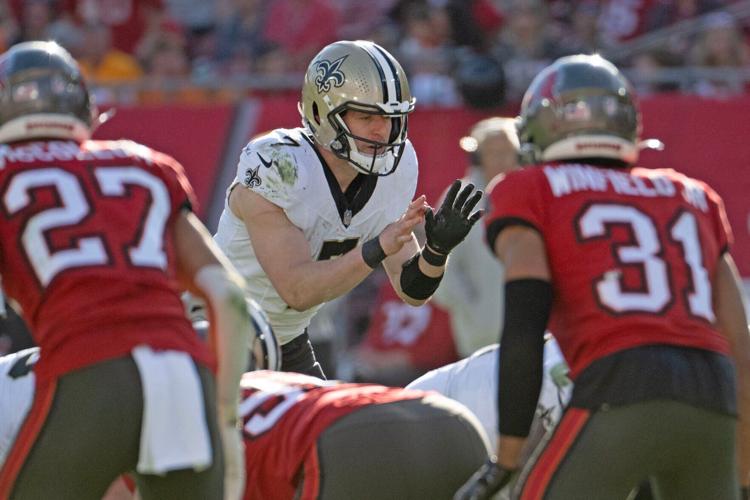New Orleans Saints coach Dennis Allen chuckled when he was asked whether there was a moment during the NFL draft when another team’s pick caused him and other decision-makers to look around the room and wonder, “What are they doing?”
It wasn’t hard to read between the lines of why the question was asked.
Not after the Atlanta Falcons, the Saints’ chief rival, surprisingly took quarterback Michael Penix eighth overall, months after signing Kirk Cousins to a four-year, $180 million deal.
“Nothing really shocks me too much,” Allen said.
Allen was being polite. But make no mistake, in a division that is as wide open as the NFC South, the Falcons’ decision to use a valuable resource on a quarterback who might not play years from now was a staggering choice given the other needs on their roster. Penix may turn out to be a great quarterback, but the selection likely did little to bolster the Falcons’ chances next season.
Once again, the NFC South appears to be there for the taking. The Falcons, even after a draft widely panned by analysts, remain the betting favorite. But the Saints and Tampa Bay Buccaneers figure to be right in the mix, with the Carolina Panthers trying to build around quarterback Bryce Young.
With the draft over, let’s take a moment to take a closer look at the division and see how each haul of prospects affects what figures to be a competitive race.
Tampa Bay Buccaneers
Draft class (round-overall): C Graham Barton (1-26), LB Chris Braswell (2-57), S Tykee Smith (3-89), WR Jalen McMillan (3-92), RB Bucky Irving (4-125), G Elijah Klein (6-220), TE Devin Culp (7-246)
Tampa Bay has had a quiet offseason, aside from re-signing quarterback Baker Mayfield, wide receiver Mike Evans and a handful of others. Tampa Bay’s draft class isn’t splashy, but general manager Jason Licht continued to build on what has been a solid roster in the post-Tom Brady era. Barton plugs a hole on the interior that’s been there since Ryan Jensen’s career-ending knee injury in 2022. Irving has a chance to add some juice to the backfield and complement starter Rachaad White.
Tampa Bay surprised a year ago, though its offense will need to improve in 2024. The Buccaneers, too, lost offensive coordinator Dave Canales when the Panthers hired him to be their next coach. Former Rams offensive coordinator Liam Cohen, Canales’ replacement, will be tasked with building on the momentum from last year.
New Orleans Saints
Draft class: T Taliese Fuaga (1-14), CB Kool-Aid McKinstry (2-41), QB Spencer Rattler (5-150), WR Bub Means (5-170), LB Jaylan Ford (5-175), DT Khristian Boyd (6-199) and T Josiah Ezirim (7-239)
The Saints landed two starting-caliber players in Fuaga and McKinstry, but where they will start is still up in the air. Fuaga’s spot depends on whether right tackle Ryan Ramczyk (knee) can play in 2024. If he can, Fuaga will presumably kick over to the left despite not playing there in college. The Saints see McKinstry as an outside corner who can play the slot, and his spot could depend on whether Marshon Lattimore is traded. But both picks made sense and raise the overall talent level on the roster.
The other selections add depth, though Ford and Boyd perhaps have a chance to see the field early on if they prove to be capable run defenders. This was an uncharacteristic Saints draft, as they weren’t overly aggressive about trading up, only doing so once to take McKinstry. But under the radar, the Saints have now had back-to-back drafts with at least seven selections for the first time since 2017-18.
Atlanta Falcons
Draft class: QB Michael Penix (1-8), DT Ruke Orhorhoro (2-35), DE Bralen Trice (3-74), DE Brandon Dorlus (4-109), LB JD Bertrand (5-143), RB Jase McClellan (6-186), WR Casey Washington (6-187) and DL Zion Logue (6-197)
Penix wasn’t the only reason the Falcons’ draft was panned. Analysts took issue with trading up for Orhorhoro and some of Atlanta’s Day 3 selections, though people largely liked the Dorlus pick. The Falcons need pass rush help, and while Dorlus could be a solution there, that spot is still a question mark.
The Falcons are confusing in part because they seem to lack an identity. Are they rebuilding under new coach Raheem Morris? Well, no, because they signed Cousins to a gigantic contract and then surrounded him with new weapons such as Darnell Mooney and Rondale Moore. Atlanta can point to other teams such as the Green Bay Packers and Kansas City Chiefs who used first-round picks on their quarterbacks of the future despite having an established starter in place. But rarely have we seen it when that starter in place is also brand-new to the team and with such a high pick in the draft. That is what makes the 2024 Falcons fascinating, and they seem headed for a season that’s either an overwhelming success or a disaster, with no in-between.
Carolina Panthers
Draft class: WR Xavier Legette (1-32), RB Jonathan Brooks (2-46), LB Trevin Wallace (3-72), TE Ja’Tavion Sanders (4-101), DB Chau Smith-Wade (5-157), DT Jaden Crumedy (6-200), LB Michael Barrett (7-240)
David Tepper’s stop at a Charlotte restaurant that had posted a “please let the coach & GM pick this year” sign created another set of headlines for a team whose owner seems to dominate them. But more important for the Panthers: Can they get Young some help? The Panthers’ draft seemed to do that with Legette and Brooks in the first and second rounds.
This upcoming season for the Panthers will be about whether Young, the 2023 first overall pick, is the right quarterback to build the future around. If this year doesn’t go well — and it was rough for the rookie in 2023 — Carolina might have to think about other options.



